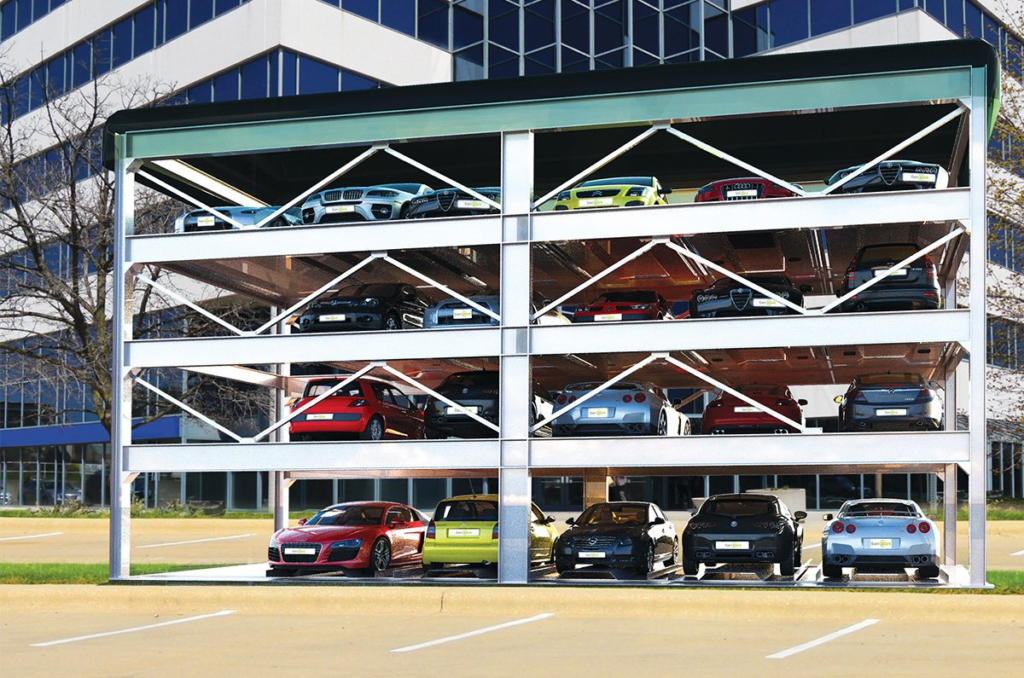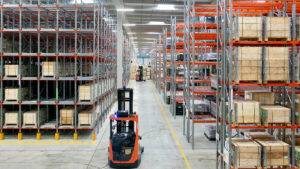In the dynamic landscape of urban development, parking solutions play a pivotal role in optimizing space utilization and enhancing convenience for residents and visitors alike. This article in mechanical car parking in real estate offers a comprehensive overview of various types of mechanical car parking options, highlighting their use, applicability, and key differences compared to regular surface car parking.
Rapid industrialization has contributed immensely to the growth rate of the urban economy and the living standard of individuals all over the world, which resulted in two decades of exponential increase in the number of registered vehicles hitting the streets. The number of cars worldwide is projected to upsurge to 2 Billion by 2040, with the maximum rise expected to be in emerging markets like India and China. (Source: Weforum.org) Urban areas have a higher concentration of vehicles compared to rural areas. (Source: Statista.com) This increasing concentration of cars in the cities has led to a shortage of parking spaces and an instantaneous need to effectively manage the parking systems.
According to worldwide research, 30 per cent of the traffic can be attributed to improper parking services, especially in cities, during peak hours. This problem will only worsen in the coming years if left unaddressed.
What is Mechanical Car Parking?
Mechanical car parking, also referred to as automated or robotic parking, represents a transformative solution to urban parking challenges by efficiently utilizing vertical space. Unlike traditional parking structures where vehicles are parked horizontally side by side, mechanical systems employ automated platforms, lifts, or conveyors to stack vehicles vertically. This technology is crucial in densely populated urban environments where land availability for parking is limited. By maximizing the number of vehicles parked within a smaller footprint, mechanical car parking systems help optimize urban space usage while meeting the growing demand for parking facilities.
These systems typically feature advanced components such as car elevators, pallets, and transfer mechanisms that operate under computerized control. This automation streamlines the parking and retrieval process, offering convenience to users while reducing the time and space required for parking operations. Moreover, mechanical car parking enhances safety and security through features like controlled access and surveillance, addressing concerns related to vehicle theft and vandalism in urban settings. As cities continue to grow and space becomes increasingly scarce, the adoption of mechanical car parking systems is poised to play a pivotal role in shaping sustainable and efficient urban development strategies.
Why should Real Estate Projects have Mechanical Car Parking?
Real estate projects benefit significantly from incorporating mechanical car parking systems due to several compelling reasons. Firstly, in metropolitan areas facing a scarcity of space, traditional parking facilities such as basement lots are becoming increasingly insufficient to meet the growing demand for parking spaces. With the rapid increase in the number of vehicles, especially in urban centers, there is a pressing need for more efficient use of available space. Mechanical parking systems address this challenge by vertically stacking vehicles, thereby maximizing parking capacity within a smaller footprint.
According to building regulations and guidelines set by authorities like the Ministry of Housing and Urban Affairs, real estate developments are required to provide a certain number of parking spaces per unit area to ensure adequate parking provisions for residents. For instance, the requirement of 2 Equivalent Car Spaces (ECS) per 100 square meters of floor area in residential premises underscores the need for efficient parking solutions. Mechanical parking systems not only enable compliance with these regulations but also enhance the operational efficiency of parking facilities in both residential and commercial properties.
Moreover, the implementation of a mechanical parking management system streamlines the process of parking and retrieval, reducing the time spent by residents and visitors searching for parking spaces. This enhanced efficiency contributes to improving the overall residential lifestyle by minimizing congestion and optimizing traffic flow within the premises. Additionally, by utilizing vertical space effectively, these systems contribute to sustainable urban development practices, preserving valuable land resources and supporting environmental conservation efforts.
Integrating mechanical car parking systems into real estate projects not only addresses the immediate need for adequate parking but also enhances the value proposition of the property. It offers a practical solution to urban space constraints, aligns with regulatory requirements, improves operational efficiency, and ultimately enhances the quality of life for residents while supporting broader economic and environmental objectives.
Also explore on Density and Population – Real Estate Development & City Planning
Difference between Mechanical Car Parking & Surface / Podium Car Parking
The difference between mechanical car parking and surface/podium car parking lies in their design, functionality, and utilization of space:
Design and Structure:
- Mechanical Car Parking: The design focuses on vertical stacking to maximize parking density. Automated platforms and lifts enable vehicles to be parked in layers, reducing the overall footprint required for parking. This design is particularly advantageous in urban environments where space is at a premium.
- Surface/Podium Car Parking: This design utilizes horizontal space with vehicles parked side by side. It often involves creating flat or elevated surfaces like parking garages or open-air lots, where vehicles are parked in rows. This layout is more common in suburban or less densely populated areas.
Space Utilization:
- Mechanical Car Parking: By stacking vehicles vertically, mechanical systems efficiently utilize available space, allowing more cars to be accommodated within a smaller area. This approach is essential in congested cities where maximizing land use is critical.
- Surface/Podium Car Parking: This method requires more land for parking because vehicles are parked horizontally, occupying larger surface areas compared to stacked parking. It’s suitable where ample land is available and space constraints are less severe.
Automation and Technology:
- Mechanical Car Parking: Automation is a key feature, with computerized systems controlling the parking and retrieval process. This automation enhances efficiency, reduces the need for human intervention, and improves overall operational reliability.
- Surface/Podium Car Parking: While some facilities may integrate technology for ticketing or surveillance, the core process of parking and retrieving vehicles relies on manual operation by drivers, which can lead to slower throughput and potential congestion during peak times.
Construction and Installation:
- Mechanical Car Parking: Installing mechanical systems involves specialized construction to accommodate equipment like car elevators, pallets, and transfer mechanisms. Structural considerations are crucial to support the weight and movement of stacked vehicles.
- Surface/Podium Car Parking: Construction focuses on creating a suitable flat or elevated surface for parking, including ramps, barriers, and support structures. The complexity and cost of construction can vary widely based on design requirements and site conditions.
Cost and Maintenance:
- Mechanical Car Parking: Initial investment costs are higher due to the installation of automated systems and specialized equipment. However, over time, maintenance costs can be lower as automated systems typically require less ongoing upkeep compared to traditional parking facilities.
- Surface/Podium Car Parking: Initial construction costs depend on factors like materials, location, and design complexity. Maintenance costs involve regular repairs, cleaning, and security measures to ensure the safety and functionality of the parking facility.
Types of Mechanical Car Parking
Mechanical car parking types fall under different categories as explained below.
Stack Parking Systems:
Stack parking systems revolutionize urban parking by efficiently utilizing vertical space where horizontal area is scarce. These systems employ automated platforms or lifts to stack vehicles one above the other, significantly increasing the number of cars that can be parked within a limited footprint. Typically, single units of stack parking can accommodate up to 3 vehicles, while double units can handle up to 6 vehicles, making them ideal for densely populated areas where space is at a premium. The design restricts car heights to 150-170 cm, with platform capacities ranging up to 2000 kgs. Extended configurations allow heights of up to 270 cm for single units and 500 cm for double units, catering to various vehicle sizes and weights. Stack parking systems are further categorized into independent and dependent types, offering flexibility in parking arrangements and optimizing space efficiency in urban environments.
Independent Stack Parking
Independent stack parking systems are designed to allow each parking space to be accessed independently without the need to move other vehicles. This setup is particularly advantageous in environments where space is limited and individual access and retrieval are essential. By eliminating the dependency on other parked cars, users have the flexibility to retrieve their vehicles quickly and efficiently. This type of parking system is ideal for smaller spaces within urban areas or compact parking facilities, offering convenience and ease of use without the logistical challenges of maneuvering other vehicles.

Dependent Stack Parking
Dependent stack parking involves stacking cars one above the other in a sequential manner, where the retrieval of a vehicle may require moving other parked cars. This system maximizes vertical space utilization efficiently, making it suitable for larger parking facilities that need to accommodate a high volume of vehicles within a confined area. By stacking vehicles vertically, this method optimizes the use of available space, providing an effective solution for urban areas with limited ground space. While it requires a systematic approach to access vehicles in the correct order, dependent stack parking offers significant advantages in maximizing parking capacity and efficiency.

Puzzle or Puzzle Lift Parking
Puzzle or puzzle lift parking systems employ a combination of horizontal and vertical movements to park and retrieve vehicles, offering efficient utilization of parking space. These systems are designed to provide high-density parking configurations with flexible arrangements, making them suitable for both residential and commercial properties. By utilizing advanced mechanized platforms or lifts, puzzle parking systems optimize space by arranging vehicles in intricate patterns that maximize available parking slots. This method is particularly beneficial in densely populated urban areas where land is scarce, offering a versatile solution to meet parking demands while maintaining operational efficiency and convenience for users.

Semi-Automatic Parking Systems:
Semi-automatic parking systems represent a hybrid approach between manual and fully automated parking solutions, offering a balance of user control and automated convenience. These systems typically involve electromechanical or hydraulic mechanisms that assist in parking and retrieving vehicles with minimal manual effort. Electromechanical twin park and hydraulic twin park systems utilize advanced technology to streamline the parking process, ensuring efficient use of space in both residential and commercial developments. They provide users with the ease of automated parking while retaining some level of manual control, making them suitable for environments where space optimization and user convenience are priorities.
Electromechanical Twin Park (E TP)
The electromechanical twin park system represents a semi-automatic parking solution designed for medium to large parking facilities. Utilizing advanced electromechanical mechanisms, this system ensures reliable and controlled parking operations. It is ideal for urban environments where maximizing parking capacity within limited space is crucial. The system’s efficiency lies in its ability to handle multiple vehicles efficiently, offering flexibility in parking arrangements while optimizing space utilization. It integrates electromechanical lifts and platforms to streamline the parking process, enhancing convenience for users and contributing to efficient management of parking facilities.

Hydraulic Twin Park (H TP)
The hydraulic twin park system is engineered for heavy-duty parking operations, employing robust hydraulic systems to lift and park vehicles. Designed to handle heavier vehicles and endure urban demands, this semi-automatic system ensures durable and adaptable parking solutions. It is particularly suitable for urban settings where flexibility and durability are essential. The hydraulic technology enables efficient space utilization by maximizing parking capacity within a given area. This system enhances operational efficiency in large parking facilities, catering to the diverse needs of urban environments while maintaining reliability and performance.

Stage Over Ground Type Dependent
The three-stage over ground type dependent parking system offers a versatile configuration that maximizes parking capacity in large facilities. This semi-automatic system is characterized by its ability to stack vehicles vertically across multiple levels, optimizing space utilization. Ideal for urban environments with high parking demand, it provides a reliable solution that balances efficiency and accessibility. The system’s design allows for sequential parking and retrieval of vehicles, ensuring organized and streamlined operations. It is well-suited for properties seeking to maximize parking efficiency while managing space constraints effectively.

2 Stage Pit Type Dependent
The two-stage pit type dependent parking system utilizes a pit for parking, allowing vehicles to be parked underground to optimize surface space. This semi-automatic solution is designed for urban settings where surface area is limited but vertical space can be utilized effectively. By integrating a pit for vehicle storage, the system reduces the footprint required for parking facilities while offering adaptable configurations. It provides efficient and space-saving parking solutions, accommodating varying vehicle sizes and optimizing operational efficiency in dense urban environments.

OGP (Over Ground Puzzle) – Independent – Electromechanical
The over ground puzzle (OGP) independent electromechanical system combines horizontal and vertical movements using advanced electromechanical mechanisms. This semi-automatic system is tailored for properties aiming to maximize parking capacity while maintaining flexibility in parking operations. It utilizes innovative technology to maneuver vehicles both horizontally and vertically, optimizing space utilization across different levels. The system’s independent configuration allows for efficient parking arrangements without affecting neighboring vehicles, enhancing accessibility and convenience for users. It is suitable for urban properties seeking versatile parking solutions that integrate advanced electromechanical features for reliable and efficient parking management.

1, 2, 3 in Pit with OG Configurations
The configurations involving 1, 2, and 3 vehicles in pits with over ground arrangements offer diverse layouts to optimize space utilization in urban environments. These semi-automatic systems combine pit-based vehicle storage with over ground parking configurations, providing adaptable solutions for properties with limited surface space. They cater to varying parking demands by offering different layouts that accommodate multiple vehicles efficiently. Designed to enhance operational flexibility and maximize parking efficiency, these systems integrate pit and over ground parking elements to streamline parking operations and ensure effective space management in dense urban settings.

1 in Pit with OG Configuration

2 in Pit with OG Configuration

3 in Pit with OG Configuration
Fully Automatic Parking Systems:
Fully automatic parking systems epitomize the pinnacle of parking technology, offering seamless and efficient parking solutions with minimal human intervention. These systems utilize advanced robotics, sensors, and computerized controls to autonomously park and retrieve vehicles. Mini rotary types, steel structure-based designs in both lengthwise and breadthwise configurations, and below-ground systems with corner entry designs are examples of their diverse applications. By eliminating the need for manual driving and parking, fully automatic systems maximize space utilization and enhance user convenience in dense urban environments. They cater to residential complexes, commercial buildings, and mixed-use developments, providing efficient parking solutions that optimize land use and elevate the overall experience for users.
Mini Rotary Type
The mini rotary type parking system employs a rotary mechanism to efficiently park vehicles in compact urban environments. This fully automatic system is designed to maximize parking space by utilizing rotational movements, allowing vehicles to be parked and retrieved with minimal space requirements. Ideal for areas where land is scarce and parking demands are high, the mini rotary type system offers reliable and efficient solutions to urban congestion. By rotating vehicles into place, it optimizes the use of available space while ensuring convenient access and retrieval for users.

Steel Structure Based (Lengthwise, Breadthwise)
Steel structure-based parking systems are characterized by their robust construction and customizable layouts, which can be configured either lengthwise or breadthwise. These systems provide high-density parking solutions suitable for urban areas that require efficient and durable parking structures. By utilizing steel frameworks, these systems offer versatility in design while ensuring structural integrity and longevity. Whether installed alongside buildings or as standalone structures, steel structure-based parking systems cater to urban developments aiming to maximize parking capacity without compromising on reliability or operational efficiency.

Steel Structure based – Lengthwise

Steel Structure based – Breadthwise
Below Ground with Corner Entry Design
Below ground parking systems with corner entry design optimize surface area by concealing parking spaces underground. This configuration is particularly beneficial for properties in urban areas where above-ground space is limited. By utilizing the corner entry design, vehicles can access parking spaces efficiently while maximizing the use of underground space. This system provides a discreet and space-saving solution to parking needs, enhancing the aesthetic appeal of developments while meeting the practical requirements of modern urban planning.

Hydraulic Lift and Traction Lift
Hydraulic lift and traction lift systems are advanced parking solutions that utilize vertical movement mechanisms for efficient parking operations. Hydraulic lift systems employ hydraulic mechanisms to lift and lower vehicles, ensuring reliable and precise positioning within parking facilities. On the other hand, traction lift systems utilize traction mechanisms for vertical movement, offering efficient and space-saving solutions in urban environments. Both systems are designed to maximize space utilization while providing convenient access and retrieval for users, making them ideal for modern developments that prioritize efficient use of parking space and operational reliability.

Hydraulic Type

Traction Type
Chess Parking System:
The chess parking system represents a sophisticated multi-level parking solution designed to optimize space utilization in urban environments. This system is typically constructed using reinforced concrete framework and accommodates a significant number of vehicles, often around 225 cars. It operates with motorized transfer and lifting mechanisms, usually wire rope-based, to facilitate efficient parking and retrieval processes. Chess parking systems are characterized by their modular approach, where multiple levels are accessible via entry and exit modules on the ground floor, ensuring smooth vehicle movement. This design minimizes the footprint required for parking while maximizing capacity, making it suitable for both residential and commercial properties seeking high-density parking solutions in limited space.

Automatic Robotic Parking:
Automatic robotic parking systems represent a revolutionary advancement in urban parking solutions, utilizing state-of-the-art robotics and automation to optimize efficiency and convenience. These systems employ advanced conveyor technology and robotic platforms to park and retrieve vehicles both horizontally and vertically, eliminating the need for manual driving. They are categorized into fully automatic and semi-automatic systems, with fully automatic variants managing the entire parking process independently. Ideal for densely populated urban areas, these systems maximize parking capacity within limited space, contributing to reduced urban sprawl and enhanced sustainability. They offer users swift and secure parking services, integrating advanced safety features such as surveillance and access controls. As a result, automatic robotic parking systems are increasingly integrated into modern developments seeking to improve parking efficiency while enhancing the overall user experience.

Look through Lift Regulations for Residential & Commercial Developments
Benefits of Mechanical Car Parking
Mechanical car parking systems offer a myriad of advantages when integrated into real estate projects, providing innovative solutions to address parking challenges. Here are the key benefits:
- Space Efficiency: Mechanical parking systems maximize the utilization of available space by stacking vehicles vertically. This allows real estate developers to accommodate more parking spots within a smaller footprint, optimizing land usage and increasing the overall property value.
- Compliance with Regulations: With strict regulations governing parking provisions in real estate projects, mechanical car parking systems help developers meet compliance requirements efficiently. By maximizing parking capacity within limited space, these systems ensure adherence to local building codes and zoning regulations.
- Enhanced Convenience: Residents and tenants benefit from the convenience of mechanical parking systems, which provide easy access to parking facilities without the hassle of navigating through congested parking lots or searching for vacant spots. Automated features streamline the parking process, saving time and effort for users.
- Improved Safety and Security: Mechanical parking systems incorporate advanced safety features such as sensors, alarms, and surveillance cameras to ensure the safety and security of parked vehicles. With controlled access and monitoring capabilities, these systems help prevent theft, vandalism, and unauthorized access, enhancing overall security within the property.
- Cost Savings: While the initial investment in mechanical parking systems may be higher compared to traditional parking structures, they offer long-term cost savings. Reduced construction time and lower maintenance requirements contribute to lower operational costs over the lifespan of the project, providing a favorable return on investment for developers.
- Environmental Sustainability: By optimizing space and minimizing land usage, mechanical car parking systems support environmental sustainability initiatives in real estate projects. They help reduce urban sprawl, preserve green spaces, and promote eco-friendly development practices, aligning with sustainability goals and regulations.
- Flexibility in Design: Mechanical parking systems offer flexibility in design and configuration, allowing developers to customize solutions based on project requirements and site constraints. Whether integrated into high-rise buildings, mixed-use developments, or standalone parking facilities, these systems can be tailored to fit specific space limitations and architectural designs.
- Enhanced Property Value: The inclusion of mechanical car parking systems adds value to real estate projects by providing a sought-after amenity for residents and tenants. Properties with efficient parking solutions command higher market value and attract discerning buyers and tenants looking for convenience and accessibility.
In conclusion, mechanical car parking systems offer numerous benefits for real estate projects, including space efficiency, compliance with regulations, enhanced convenience, improved safety and security, cost savings, environmental sustainability, design flexibility, and increased property value. By integrating these innovative parking solutions, developers can create more attractive, functional, and sustainable properties that meet the evolving needs of urban communities.
Explore on Real Estate Feasibility – Massing Studies




